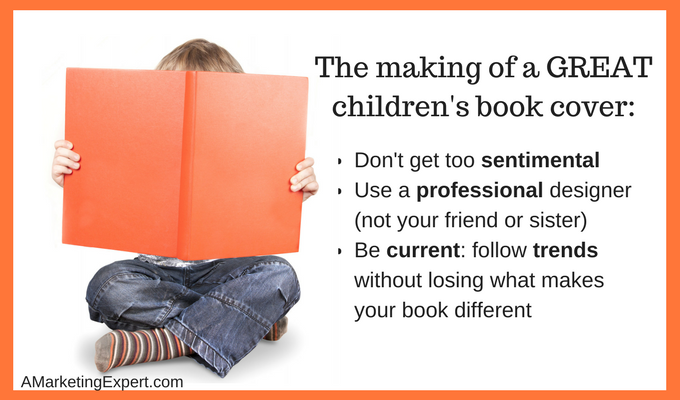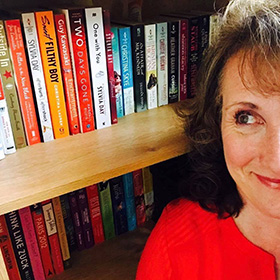Over the years, book covers across all genres have changed, but none quite as much as children’s book covers. The reason is largely that our kids have changed drastically. If you grew up in the 60s, 70s, or even 80s, the covers that appealed to you then aren’t at all what draw kids in today. By the same token, parents’ tastes have changed. Millennial moms (and even Gen-Xer moms) have very different tastes than our moms did growing up. An example of this is a Little Red Riding Hood book given to me in the 1970s. Have a look at this children’s book cover. A bit menacing, no?

How popular would this book be today? Tastes have changed quite a bit since the 70s!
Children’s books today are more sophisticated, with covers that often speak to diversity, or strong, unifying messages that parents want to instill in their children. Then there are the illustrations, which tie into the book cover. But let’s face it, if your cover isn’t strong enough, you’ll never get a parent or their child to open the book anyway.
So let’s get right down to it. Your book cover is your first impression with a potential buyer and it garners you maybe 2 seconds of initial interest if you’re lucky. That’s right, 2 seconds. So is your cover good enough to make the cut?
A few things to ask yourself as a children’s book author:
- Is the concept behind my cover design personal?
- Was my cover designed by someone I know?
- Is my cover unique when compared to Amazon’s bestseller list?
If you answered ‘yes’ to any of the above, the cover for your children’s book probably isn’t making the cut. Shocked? Let’s talk about the biggest mistakes in cover design, especially when it comes to book promotion in the children’s book market.
Sentimentality is not a marketing strategy. Thinking back to your own kid’s favorite book, your favorite book, or simpler times is not going to help you in today’s market. We see this too often, especially from authors who start writing children’s books once they have grandkids. The covers are often dated and out of touch. Yes, the idea behind them is sweet, but it’s not what attracts parents and kids today. If you’re writing your book solely to sit down with Little Johnny and wax poetically about family memories, then fine, go with your heart. Otherwise do your research and see what’s selling right now in order to determine the best direction for your book based on its grade level and story/topic. P.S. Keep in mind Little Johnny loves you and doesn’t want to hurt your feelings, so their opinion should come with a grain of salt. Reach farther for quality input.
Tied closely to the sentimental pitfall is the “my [insert family member] designed it” trap we also see a lot. Unless your family member or friend is currently employed as a graphic designer or professional artist, they shouldn’t be doing your book cover. And honestly, even those people aren’t versed in what works for books. Just like there’s a reason for specialties in medicine, there’s a reason for specialties in art. Not all artistic people have equal depth across all mediums. If you’re intent on using a design by a friend or family member, then take their concept to a professional book designer to see if you can come up with something inspired by the original that won’t tank your book’s chances.
This next one is tricky, because while you want your content, concept, and story to be unique, you don’t necessarily want your cover to be so unique it eschews all that attracts your potential buyer. Remember back to those lucky 2 seconds, it’s risky business assuming your kind of unique is the good kind. Think of it this way, you’re at the grocery store for apples. You see green and red and yellow (honestly you probably go straight to the same ones each time because it’s what you like – see the point being made here?) but throw some blue ones in there and there’s a very good chance you won’t even realize they’re apples. The same goes for children’s book covers. Be different without alienating yourself. A cover should be a delicate balance of artistry and imagery that evokes a feeling to complement and convey your topic or story. Because that feeling is the key, you get a shopper to feel that feeling – and you’ve sold a book.

Again, one of your best resources, aside from the opinion of a professional book designer, is Amazon’s bestseller list for your age group and genre. Also, consider a field trip – head to your local bookstore and see what’s on the shelves. Books that are on a bookstore shelf are there for a reason: they’ve made the cut. And these books all got the same lucky 2 seconds you’re hoping for.
There’s no magic formula for the perfect book cover, but avoiding these critical issues will put you on the right path.
BONUS TIP: Take advantage of Amazon’s listing tools especially designed for children’s books. Including details like reading level and age group in your book description can really give you an edge when parents, grandparents, family friends, and teachers with limited free time are shopping for new titles!





vey useful tips for sellers…thanks
Thank you! Glad you enjoyed it!